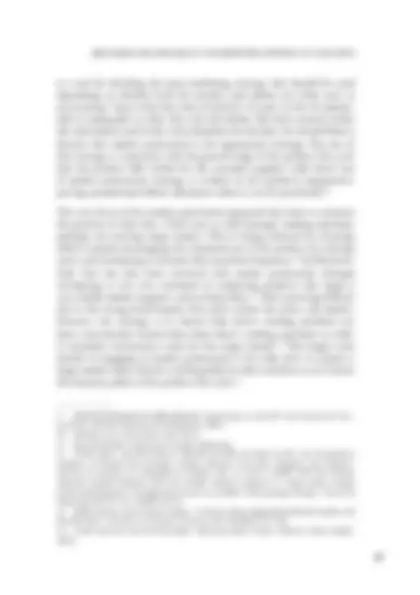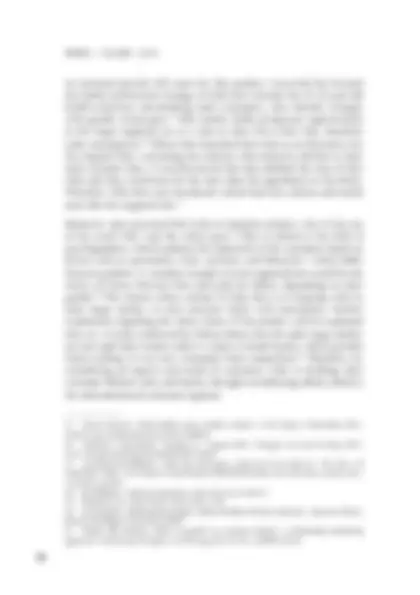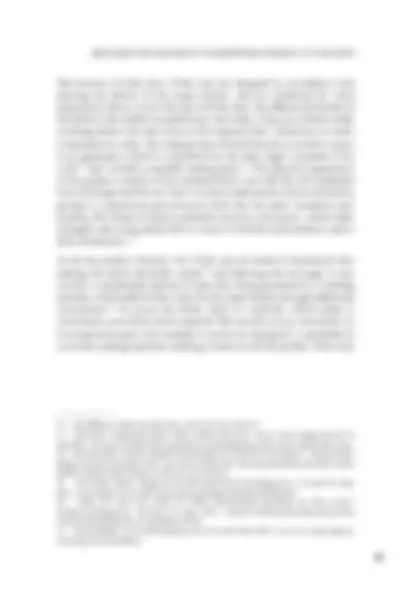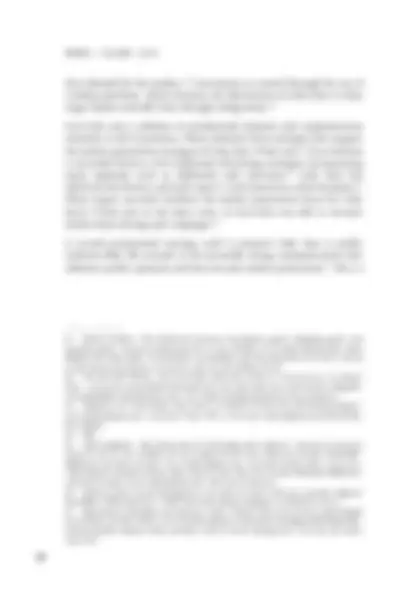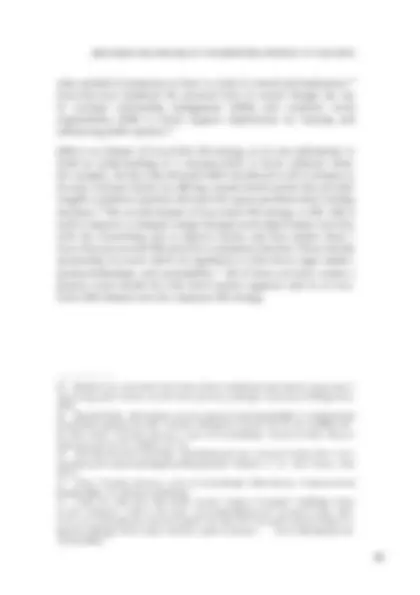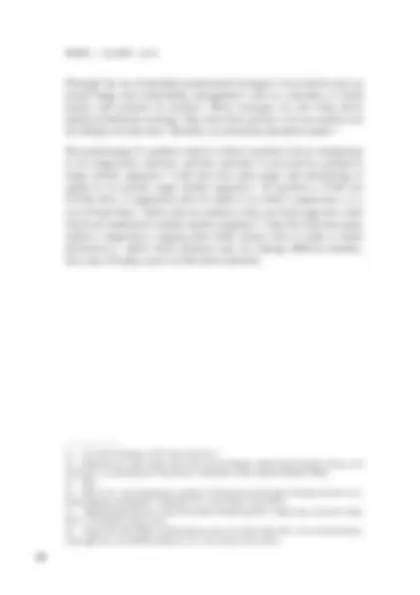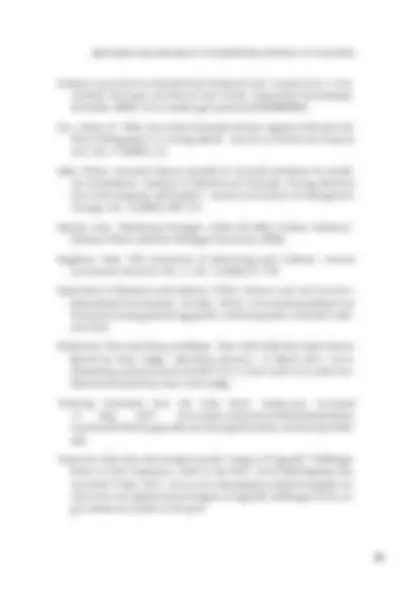Download Marketing Strategy of Coke Zero: A Case Study on Market Penetration in the US Market and more Lecture notes Marketing in PDF only on Docsity!
Discussion and analysis of the
marketing strategy of Coke Zero
in the US market
Robert Sarich, Riasat Zaman, and Chinmoy Misra
Coke Zero 375ml cans as sold in vending machines were launched in the
US market in 2005, as a sugar-free version of Coca-Cola that maintains
the same taste. The product is controlled by the Coca-Cola Company, a
multinational firm that is most famous for its namesake product Coca-
Cola, but also produces a range of sodas, spring waters, bottled teas, and
other beverages. 1 Cans of Coke Zero sold through vending machines are
marketed as a convenient product for 18–22-year-old health-conscious
male cola-drinkers who identify with masculinity. As the product is
currently within the growth stage of the product life cycle and market
penetration is the most appropriate strategy, its marketing mix strategy
has evolved accordingly. Product features, convenience pricing strategy,
customer relationship management (CRM) promotional strategy, and place
utility with vending machine distribution have all been effectively utilised
in order to maximise market penetration among the targeted customer
segment.
1 ‘2011 Year in Review’, Coca-ColaCompany.com. Accessed 9 May 2015. www.coca- colacompany.com/annual-review/2011/operating-groups.html.
MERICI — VOLUME 1, 2015
The growth stage of a product life cycle requires careful consideration in
relation to the overall marketing strategy during this time. Product life
cycle theory is useful as it provides guidance on the appropriate strategy
that should be used based on sales growth over time.^2 For the aggregate
US market, Coke Zero experienced sales growth of 5 per cent in the first
quarter of 2015, which is consistent with this growth stage.^3 However, it
is worth noting that the growth rate appears to be slowly indicating that
it may be heading towards the maturity stage in the near future, since
double-digit sales growth has frequently been reported in recent years.^4
Coke Zero’s continued growth is particularly notable, given that sales
across the entire soft drink industry have been falling slightly in the US
market in recent years. 5
Given this information, it is fair to assume that the targeted customer
segment for Coke Zero 375ml cans of health conscious 18–22-year-old male
cola drinkers who identify with masculinity is also within the growth
stage. This assumption is evidenced by the success of the marketing
strategy as discussed later.^6 Due to the fact that at this current stage of
the product life cycle, and that Coke Zero 375ml cans are already within
existing submarket of diet cola beverages, it is required that the product
being offered is precisely tailored to a very refined market segment, and
that is achieved through the specific aforementioned customer segment.^7
The marketing strategy of Coke Zero 375ml cans is best described
as market penetration, which is accordance with the Ansoff Matrix,
as well as the growth stage of the product life cycle.^8 The Ansoff Matrix
2 David Rink and John Swan, ‘Product Life Cycle. Research: A Literature Review’, Journal of Business Research , Vol. 7, Issue 3 (1979): 219–42. 3 Paul La Monica. ‘Diet Coke Sales Fizzle’, CNNMoney , 22 April 2015. money.cnn. com/2015/04/22/investing/coke-earnings-diet-coke-coca-cola. 4 Investor’s Business Daily , ‘Demand Strong For Coke Zero, Energy Drinks’, Nasdaq, 11 April 2014. www.nasdaq.com/article/demand-strong-for-coke-zero-energy-drinks- cm343827. 5 Phil Wahba,‘Update 1-U.S. soda sales fall to lowest since 1995-report’, Reuters , 31 March
- www.reuters.com/article/2014/03/31/usa-soda-beverages-idUSL1N0MS16O20140331. 6 Coca-Cola Company, ‘2011 Year in Review’. 7 Vithala Rao and Joel Steckel, Analysis for Strategic Marketing. (Reading, MA: Addison- Wesley, 1998). 8 Michael Solomon, Andrew Hughes, Bill Chitty, Greg Marshall and Elnora Stuart. Real People, Real Choice: Marketing. 3rd ed. (Frenchs Forest, NSW: Pearson, 2014).
MERICI — VOLUME 1, 2015
As potential growth still exists for this product, Coca-Cola has focused
the market penetration strategy of Coke Zero towards the 18–22-year-old
health-conscious cola-drinking male consumers, who identify strongly
with gender stereotypes.^15 This market holds prosperous opportunities
as the target segments are at a time in their lives when they maximise
soda consumption. 16 When Coke launched Diet Coke as an alternative for
the original Coke, containing less calories, sales showed a decline in their
male customer base. It was discovered that men disliked the taste of Diet
Coke and they cared more for the taste than the ingredients in the drink.
Therefore, Coke Zero was introduced, which had zero calories and tasted
more like the original Coke. 17
Moreover, men perceived Diet Coke as feminine product, due to the use
of the word ‘Diet’ and the colour grey.^18 This is related to the field of
psychographics, which analyses the separation of the customers based on
factors such as personality traits, interests, and lifestyles,^19 which differ
between genders. A common example of such segmentation would be the
choice of colour between blue and pink for babies, depending on their
gender.^20 The chosen colour scheme of Coke Zero is in keeping with its
male target market, as men associate black with masculinity. Further
explanation regarding the colour choice of the product will be explained
later on. A study conducted by Nelson shows that the male target market
are less rigid than women when it comes to brand loyalty, which justifies
Coke’s attempt to win over consumers from competitors.^21 Therefore, by
considering all aspects and needs of customers, Coke is building their
customer lifetime value and loyalty through its marketing efforts aimed at
the aforementioned consumer segment.
15 Teresa Howard, ‘Coke finally scores another winner’, USA Today , 4 November 2011. abcnews.go.com/Business/story?id=3788224. 16 ‘Products - Data Briefs - Number 71 - August 2011’. CDC.gov. Accessed 14 May 2015. www.cdc.gov/nchs/data/databriefs/db71.html. 17 Jeremiah McWilliams, ‘Coke Zero Becomes a Hero for Coca-Cola Co’, The Star , 19 September 2010. www.thestar.com/business/2010/09/19/coke_zero_becomes_a_hero_for_ cocacola_co.html. 18 McWilliams, ‘Coke Zero Becomes a Hero for Coca-Cola Co’. 19 Solomon et al., Real People, Real Choice , 218. 20 Jane Daniels, ‘Marketing Strategies within the Baby Product Industry’, Honours Thesis. (Eastern Michigan University, 2009). 21 Nelson Oly Ndubisi, ‘Effect of gender on customer loyalty: a relationship marketing approach’, Marketing Intelligence & Planning, Vol. 24, No. 1 (2006): 48–61.
DISCUSSION AND ANALySIS OF THE MARKETING STRATEGy OF COKE ZERO
The features of Coke Zero 375ml cans are designed in accordance with
meeting the desires of the target market, and are reinforced by value
proposition theory. As for all types of Coke Zero, the differential benefit of
the drink is that unlike its predecessor, Diet Coke, it has zero calories while
retaining almost the same taste as the original Coke. 22 Moreover, in order
to maximise its value, the company has invested heavily in its look, to give
it an appearance which is considered by the male target customers to be
‘cool’ 23 and ‘socially acceptable among peers’. 24 The physical appearance
of the product consists of the standard black can with the red trademark
Coca-Cola logo and the text ‘Zero’ in white underneath it (Coca-Cola Zero),
giving it a mysterious and attractive look that the male customers were
seeking. The theme of black symbolises mystery and power, which older
teenagers and young adults like to connect with their personalities, and to
show dominance.^25
As for the product features, the 375ml cans are made of aluminium thus
making the drink thermally useful, 26 and allowing the beverage to stay
cool for a considerable amount of time after being purchased at a vending
machine, which adds further value for the target market through additional
convenience. 27 To access the drink, there is a pull-tab, which makes it
convenient, as no other tool is required. The can size is very convenient, as
it occupies less space. For example, it can fit in a backpack, a cup holder in
a car and vending machines, making it easier to sell the product. This suits
22 McWilliams, ‘Coke Zero Becomes a Hero for Coca-Cola Co’. 23 Jeff Goins, ‘Marketing Works: Why I Drink Coke Zero,’ Goins, Writer (blog). Posted 12 May 2011. Accessed 10 May 2015, goinswriter.com/marketing-works-why-i-drink-coke-zero/. 24 Miranda Hale, ‘Gender-Targeted Advertising, Or “Coke Zero Is For Bros!”’, Miranda Hale (blog). Posted 6 November 2011. Accessed 14 May 2015, mirandacelestehale.net/2011/11/06/ gender-targeted-advertising-or-coke-zero-is-for-bros/. 25 ‘The Colour Black’, Empower-Yourself-With-Colour-Psychology.com. Accessed 16 May
- www.empower-yourself-with-color-psychology.com/color-black.html. 26 ‘What are soda cans made of? What environmental problems do they cause?’ Antoine.frostburg.edu. Accessed 16 May 2015. antoine.frostburg.edu/chem/senese/101/ environmental/faq/soda-can-problems.shtml. 27 ‘Sustainability’, Coca-ColaCompany.com. Accessed 9 May 2015. www.coca-colacompany. com/topics/sustainability/.
DISCUSSION AND ANALySIS OF THE MARKETING STRATEGy OF COKE ZERO
the United States of America. 33 Government regulation restricts the
sale of sugary drinks in some areas of the target segment in America. 34
Furthermore, consumer trends are moving away from sugary beverages
and towards those with healthier images. 35 These trends, coupled with
similarity in price 36 among the competition, allows the cost element to be
lessened, facilitating the choice of Coke Zero due to its healthier image. 37
A major component of pricing is demand; pricing can be strategically
altered to manipulate the level of demand.^38 As demand can be estimated
from controllable variables,^39 Coke Zero was able to benefit from increased
demand with short-term promotional strategies by using penetration
pricing. 40 Another element of the demand of Coke Zero 375ml cans is
the sale of convenience. Convenience can be used to increase utility and
33 ‘Globalization and the Coca-Cola Company’, Saylor.org. Accessed 2 May 2015. www. saylor.org/site/wp-content/uploads/2013/02/BUS208-2.5.6-Globalization-and-The-Coca- Cola-Company-FINAL.pdf; ‘Coca-Cola (One Can)’, Humuch.com. Accessed 10 May 2015. www.humuch.com/prices/CocaCola-one-can-12oz350ml/______/110#.VVXqsZOeDGd. 34 Chris Dolmetsch and Henry Goldman, ‘New York Soda Size Limit Statute Barred by State Judge’, Bloomberg Business , 12 March 2013. www.bloomberg.com/news/articles/2013-03-11/ new-york-city-soda-size-limitations-barred-by-state-court-judge; ComLaw, Australia New Zealand Food Standards Code - Standard 2.6.2 - Non-Alcoholic Beverages and Brewed Soft Drinks. (Australian Government, December 2000). www.comlaw.gov.au/Series/F2009B00004. 35 Sue Mitchell, ‘Coca-Cola puts lid on new product Coke Life until April’, The Sydney Morning Herald , 30 October 2014. www.smh.com.au/business/cocacola-puts-lid-on-new- product-coke-life-until-april-20141029-11dpd1.html. 36 Dahr et al., ‘An Econometric Analysis of Brand-Level Strategic Pricing between Coca- Cola Company and PepsiCo’. 37 Rachel Clemons, ‘Diet Cola Myths Exposed’, Choice.com.au, 16 March 2007. www. choice.com.au/food-and-drink/drinks/sports-drinks-energy-drinks-and-soft-drinks/ articles/diet-cola-myths-exposed; Mitchell, ‘Coca-Cola puts lid on new product Coke Life until April’. 38 Solomon et al., Real People, Real Choice. 39 Ibid. 40 Paul McIntyre, ‘Coke’s local advertising campaign a worldwide success’, Financial Review , 25 March 2013. www.afr.com/business/media-and-marketing/advertising/cokes- local-advertising-campaign-a-worldwide-success-20130324-je82m; Nicola Riches, ‘Coke smashes sales forecast with coloured cans’, AdNews , 23 March 2015. www.adnews.com. au/news/coke-smashes-sales-forecast-with-coloured-cans; P.C. Yang, ‘Pricing strategy for deteriorating items using quantity discount when demand is price sensitive’, European Journal of Operational Research, Vol. 157, No.2 (2004): 389–97.
MERICI — VOLUME 1, 2015
thus demand for the product.^41 Convenience is created through the use of
vending machines, which facilitate the distribution of Coke Zero to their
target market and add value through refrigeration.^42
Coca-Cola uses a plethora of promotional elements and communication
channels to sell its products. These elements form strategies that support
the market penetration strategies of Coke Zero 375ml cans.^43 Coca-Cola has
a successful history with traditional advertising strategies incorporating
many mediums such as billboards and television.^44 Coke Zero has
inherited this history and built upon it with innovative advertisements. 45
These repeat successes facilitate the market penetration focus for Coke
Zero’s 375ml cans in the short term, as Coca-Cola was able to increase
market share during each campaign. 46
A second promotional strategy used to promote Coke Zero is public
relations (PR). PR extends to all outwardly facing communications that
influence public opinions and thus increase market penetration. 47 PR is a
41 Richard Holton, ‘The distinction between convenience goods, shopping goods, and specialty goods’, Journal of Marketing, Vol. 23, No. 1(1958): 53–56; Mark Jekanowski, James Binkley and James Eales, ‘Convenience, accessibility, and the demand for fast food’, Journal of Agricultural and Resource Economics, Vol. 26, No.1 (2001): 58–74. 42 AP and Staff Writers, ‘Are Coca-Cola’s mini-cans worth it?’ News.com.au , 15 January
- www.news.com.au/finance/business/are-coca-colas-mini-cans-worth-it/story-fnkgdftz- 1227184568698; CokeSolutions.com, ‘Get a Coke Vending Machine for Your Business’. 43 Solomon et al., Real People, Real Choice ; ‘A History of Coca-Cola Advertising Slogans’, Coca-ColaCompany.com. Accessed 9 May 2015. www.coca-colacompany.com/stories/coke- lore-slogans. 44 Ibid. 45 John Deighton, ‘The interaction of advertising and evidence’, Journal of Consumer Research, Vol. 11, No. 3 (1984): 763–70; ‘A Sign of Great Taste: Coke Zero Unveils “Drinkable” Billboards and More in Indy’, Coca-ColaCompany.com. Accessed 10 May 2015. www.coca- colacompany.com/innovation/a-sign-of-great-taste-coke-zero-unveils-drinkable-billboards- and-more-in-indy; Coca-ColaCompany.com, ‘2011 Year in Review’. 46 Andrew Lester, Growth Management: Two Hats are Better Than One. (London: Palgrave Macmillan, 2009); McIntyre, ‘Coke’s local advertising campaign a worldwide success’. 47 Department of Business and Industry, Public relations tools and activities, (Queensland Government, October 2014). www.business.qld.gov.au/business/running/marketing/public- relations/public-relations-tools-activities; Lester, Growth Management: Two Hats are Better Than One.
MERICI — VOLUME 1, 2015
Through the use of multiple promotional strategies, Coca-Cola focuses on
brand image and relationship management with its customers to build
loyalty and promote its product. These strategies tie into Coke Zero’s
market penetration strategy; they have been proven to be successful over
the lifespan of Coke Zero, therefore no alterations should be made.^53
The positioning of a product refers to where a product sits in comparison
to its competition, and how well this ‘position’ is received by a product’s
target market segments.^54 Coke Zero has used target and positioning to
appeal to its specific target market segments.^55 To position a 375ml can
of Coke Zero, a comparison must be made to its closest competitors, i.e. a
can of Pepsi Max. 56 Both colas are similar as they are both sugar-free colas
which are marketed to similar market segments. 57 Coke Zero also has many
indirect competitors, ranging from home brand colas to make at home
alternatives.^58 Albeit these products may be chasing different markets,
they may still play a part in Coke Zero’s position.
53 Coca-Cola Company, ‘2011 Year in Review’. 54 Solomon et al., Real People, Real Choice ; Stuart Rogers, Marketing Strategies, Tactics, and Techniques: A Handbook for Practitioners. (Westport, Conn: Quorum Books. 2001). 55 Ibid. 56 Dahr et al., ‘An Econometric Analysis of Brand-Level Strategic Pricing between Coca- Cola Company and PepsiCo’; Solomon et al., Real People, Real Choice. 57 ‘Official Global Partner of the ICC Cricket World Cup 2015’, Pepsi.com. Accessed 7 May
- www.pepsi.com/en-au/d. 58 ‘Sugar Free Cola 500ml’, SodaStreamUsa.com. Accessed 9 May 2015. www.sodastreamusa. com/sugar-free-cola-500ml; Solomon et al., Real People, Real Choice.
DISCUSSION AND ANALySIS OF THE MARKETING STRATEGy OF COKE ZERO
Coke Zero doesn’t have a competitive advantage in terms of price or product.^59
One element of Coke Zero that is well coveted is its ‘secret formula’.^60
However, this exclusivity cannot be retained with competitors creating
‘close enough’ substitutes.^61 Brand loyalty is a competitive advantage for
Coke Zero as it is a reason Coke Zero is chosen over substitutes. 62
Coke Zero’s marketing mix of price, place, product and promotion has been
developed to align with the product’s market penetration focus. As Coke
Zero’s pricing will be mimicked by its competition, specifically Pepsi Max, 63
Coca-Cola uses cost in conjunction with other elements such as promotion
or baselined at a reasonable level.^64 A can of Coke Zero is positioned similarly
to its competitors in terms of form and place utility, however perceived
possession utility is increased through the use of attractive colours.^65 As
previously stated, one of Coke Zero’s advantages is its customer loyalty.
The company’s relationship- and image-based promotional strategy aim is
to retain and build upon the loyalty of its chosen market segment. As Coke
Zero is an existing product entering the maturity phase of its life cycle,
Coca-Cola is focusing on market penetration. The product’s distribution
strategies support this by increasing the availability of Coke Zero at lower
59 Dahr et al., ‘An Econometric Analysis of Brand-Level Strategic Pricing between Coca- Cola Company and PepsiCo’; Pepsi.com, ‘Official Global Partner of the ICC Cricket World Cup 2015’. 60 Coca-ColaCompany.com, ‘Sustainability’. 61 Jessica Cox, ‘Why Coca-Cola’s Fictional Lawsuit Against Coke Zero for Taste Infringement is a Losing Battle’, Journal of Intellectual Property Law, Vol. 17 (2009): 121. 62 Ailawadi, Lehmann and Neslin, ‘Market response to a major policy change in the marketing mix: Learning from Procter & Gamble’s value pricing strategy’; ‘Drawing Customers Into the Coke Zone’, Aimia.com. Accessed 13 May 2015. www.aimia.com/content/ dam/aimiawebsite/CaseStudiesWhitepapersResearch/english/Aimia_CaseStudyCOKE.pdf. 63 Dahr et al., ‘An Econometric Analysis of Brand-Level Strategic Pricing between Coca- Cola Company and PepsiCo’. 64 Clemons, ‘Diet Cola Myths Exposed’; Mitchell, ‘Coca-Cola puts lid on new product Coke Life until April’; Ailawadi, Lehmann and Neslin, ‘Market response to a major policy change in the marketing mix: Learning from Procter & Gamble’s value pricing strategy’; Jekanowski, Binkley and Eales. ‘Convenience, accessibility, and the demand for fast food’. 65 ‘What Are the Four Types of Utility Marketing?’ SmallBusiness.Chron.com. Accessed 14 May 2015. smallbusiness.chron.com/four-types-utility-marketing-24420.html; Goins, ‘Marketing Works: Why I Drink Coke Zero’.
DISCUSSION AND ANALySIS OF THE MARKETING STRATEGy OF COKE ZERO
The locations of vending machines that offer Coke Zero 375ml cans heavily
takes into account the target market. College campuses across the US have a
high number of vending machines that offer Coke Zero.^73 Through placing
vending machines at college campuses, it is ensured that the product is in
close proximity to the 18–22-year-old group. Vending machines offering
Coke Zero are also commonplace in areas such as shopping malls and food
courts frequented by young people, in order to be maximise exposure to
the key demographic and encourage purchases.^74 Furthermore, the use of
these locations is also substantiated by theory related to impulse buying
— by offering a low-cost item that requires very little commitment at a
time that is convenient for the consumer. 75
The Coca-Cola Company uses market penetration as its core marketing
strategy to sell its product — 375ml cans of Coke sold through vending
machines. As growth levels indicate the product is close to entering
the maturity stage of the product life cycle, Coca-Cola is using loyalty
and convenience to increase market penetration for its target segment,
health-conscious 18–22-year-olds who identify with masculinity in the
US. Loyalty has been increased though attractive packaging, customer
satisfaction through fair pricing, company image and relationship
management with customers/clients. Convenience is increased though
high form utility of packaging, convenient sizing and place utility though
vending machine distribution. Based on high-growth levels in recent
years, loyalty and convenience are used to successfully position Coke Zero
ahead of competitors.^76
73 Julia Lapp, William Ressler and Amy Frith, ‘College students, vending machines, and improving nutritional choices: The effects of adding healthier foods on perceptions of vending machines’, International Journal of Food Safety, Nutrition and Public Health, Vol. 5, No. 1 (2014): 16–33. 74 CokeSolutions.com, ‘Get a Coke Vending Machine for Your Business’. 75 John West, ‘Results of two years’ of study into impulse buying’, Journal of Marketing, Vol. 15, No. 1 (1951): 362–63. 76 Coca-Cola Company, ‘2011- Year in Review’.
MERICI — VOLUME 1, 2015
References
‘2011 Year in Review’, Coca-ColaCompany.com. Accessed 9 May 2015.
www.coca-colacompany.com/annual-review/2011/operating-groups.html.
‘A History of Coca-Cola Advertising Slogans’, Coca-ColaCompany.com.
Accessed 9 May 2015. www.coca-colacompany.com/stories/coke-lore-
slogans.
‘A Sign of Great Taste: Coke Zero Unveils ‘Drinkable’ Billboards and More
in Indy’, Coca-ColaCompany.com. Accessed 10 May 2015. www.coca-
colacompany.com/innovation/a-sign-of-great-taste-coke-zero-unveils-
drinkable-billboards-and-more-in-indy.
Ailawadi, Kusum L., Donald R. Lehmann and Scott A. Neslin. ‘Market
response to a major policy change in the marketing mix: Learning from
Procter & Gamble’s value pricing strategy’, Journal of Marketing, Vol.
65, No. 1 (2001): 44–61.
AP and Staff Writers. ‘Are Coca-Cola’s mini-cans worth it?’ News.com.au,
15 January 2015. www.news.com.au/finance/business/are-coca-colas-
mini-cans-worth-it/story-fnkgdftz-1227184568698.
Bhattacharya, C.B. ‘Corporate Social Responsibility: It’s All About
Marketing’, Forbes , 20 November 2009. www.forbes.com/2009/11/20/
corporate-social-responsibility-leadership-citizenship-marketing.
html.
Bond, Shannon. ‘Coke shares gain after distribution deal’, Ft.com, 16 April
2013. www.ft.com/cms/s/0/c53dbb78-a689-11e2-885b-00144feabdc0.
html# axzz3aM3wBtq6.
Clemons, Rachel. ‘Diet Cola Myths Exposed’, Choice.com.au, 16 March
2007. www.choice.com.au/food-and-drink/drinks/sports-drinks-
energy-drinks-and-soft-drinks/articles/diet-cola-myths-exposed.
‘Coca-Cola (One Can)’, Humuch.com. Accessed 10 May 2015. www.
humuch.com/prices/CocaCola-one-can-12oz350ml/______/110#.
VVXqsZOeDGd.
MERICI — VOLUME 1, 2015
Geller, Martinne. ‘UPDATE 4 - Coca-Cola to return some distribution
to U.S. franchisers’, Reuters , 16 April 2013. www.reuters.com/
article/2013/04/16/cocacola-bottlers-idUSL2N0D30HG20130416.
‘Get a Coke Vending Machine for Your Business’, CokeSolutions.com.
Accessed 13 May 2015. www.cokesolutions.com/Vending/Pages/
Site%20Pages/Full ServiceVending.aspx.
‘Globalization and the Coca-Cola Company’, Saylor.org. Accessed 2 May
2015. www.saylor.org/site/wp-content/uploads/2013/02/BUS208-2.5.6-
Globalization-and-The-Coca-Cola-Company-FINAL.pdf.
Goins, Jeff. ‘Marketing Works: Why I Drink Coke Zero,’ Goins, Writer
(blog). Posted 12 May 2011. Accessed 10 May 2015, goinswriter.com/
marketing-works-why-i-drink-coke-zero/.
Hale, Miranda. ‘Gender-Targeted Advertising, Or “Coke Zero Is For Bros!”’,
Miranda Hale (blog). Posted 6 November 2011. Accessed 14 May 2015,
mirandacelestehale.net/2011/11/06/gender-targeted-advertising-or-
coke-zero-is-for-bros/.
Holton, Richard H. ‘The distinction between convenience goods, shopping
goods, and specialty goods’, Journal of Marketing, Vol. 23, No. 1(1958):
Howard, Teresa. 2015. ‘Coke finally scores another winner’ USA Today ,
4 November 2011. abcnews.go.com/Business/story?id=3788224.
Investor’s Business Daily. ‘Demand Strong For Coke Zero, Energy Drinks’,
Nasdaq, 11 April 2014. www.nasdaq.com/article/demand-strong-for-
coke-zero-energy-drinks-cm343827.
Jackall, Robert and Janice M. Hirota. Image makers: Advertising, public
relations, and the ethos of advocacy. (Chicago: University of Chicago
Press. 2003).
Jekanowski, Mark D., James K. Binkley and James Eales. ‘Convenience,
accessibility, and the demand for fast food’, Journal of Agricultural and
Resource Economics, Vol. 26, No.1 (2001): 58–74.
La Monica, Paul R. ‘Diet Coke Sales Fizzle’, CNNMoney , 22 April 2015.
money.cnn.com/2015/04/22/investing/coke-earnings-diet-coke-coca-cola.
DISCUSSION AND ANALySIS OF THE MARKETING STRATEGy OF COKE ZERO
Lancaster, Geoff. and Paul Reynolds. Marketing Made Simple. (Oxford:
Made Simple, 2002).
Lapp, Julia L., William H. Ressler and Amy L. Frith. ‘College students,
vending machines, and improving nutritional choices: the effects
of adding healthier foods on perceptions of vending machines’,
International Journal of Food Safety, Nutrition and Public Health,
Vol. 5, No. 1 (2014): 16–33.
McDonald, Malcom and Mike Meldrum. Marketing in a Nutshell: Key
Concepts for Non-specialists. (Oxford: Butterworth-Heinemann, 2007).
McIntyre, Paul. ‘Coke’s local advertising campaign a worldwide success’,
Financial Review , 25 March 2013. www.afr.com/business/media-
and-marketing/advertising/cokes-local-advertising-campaign-a-
worldwide-success-20130324-je82m.
McWilliams, Jeremiah. ‘Coke Zero Becomes a Hero for Coca-Cola Co’,
The Star , 19 September 2010. www.thestar.com/business/2010/09/19/
coke_zero_becomes_a_hero_for_cocacola_co.html.
Mitchell, Sue. ‘Coca-Cola puts lid on new product Coke Life until
April’, The Sydney Morning Herald , 30 October 2014. www.smh.com.
au/business/cocacola-puts-lid-on-new-product-coke-life-until-april-
20141029-11dpd1.html.
Muniz, Albert M. and Lawrence O. Hamer. ’Us Versus Them: Oppositional
Brand Loyalty and the Cola Wars’, Advances in Consumer Research, Vol.
‘My Coke Rewards Card FAQs’, MyCokeRewards.com. Accessed 14 May
2015. www.mycokerewards.com/content/legal/vending-faq.html.
‘Official Global Partner of the ICC Cricket World Cup 2015’, Pepsi.com.
Accessed 7 May 2015. www.pepsi.com/en-au/d.
Oly Ndubisi, Nelson. ‘Effect of gender on customer loyalty: a relationship
marketing approach’, Marketing Intelligence & Planning, Vol. 24, No. 1
‘Products - Data Briefs - Number 71 - August 2011’. CDC.gov. Accessed 14
May 2015. www.cdc.gov/nchs/data/databriefs/db71.html.
DISCUSSION AND ANALySIS OF THE MARKETING STRATEGy OF COKE ZERO
‘What are soda cans made of? What environmental problems do they cause?’
Antoine.frostburg.edu. Accessed 16 May 2015. antoine.frostburg.edu/
chem/senese/101/environmental/faq/soda-can-problems.shtml.
‘What Are the Four Types of Utility Marketing?’ SmallBusiness.Chron.
com. Accessed 14 May 2015. smallbusiness.chron.com/four-types-
utility-marketing-24420.html.
Yang, P.C. ‘Pricing strategy for deteriorating items using quantity discount
when demand is price sensitive’, European Journal of Operational
Research, Vol. 157, No. 2 (2004): 389–97.
This text is taken from Merici, Volume 1, 2015 , edited by Henry
Poetrodjojo, Ilze Alexander and Lauren Prossor, published 2016 by
ANU eView, The Australian National University, Canberra, Australia.

